Hoya Burtoniae vs Bilobata – Differences & Similarities
Have you ever had any confusion between Hoya Burtoniae vs Hoya Bilobata? These are amazing creations included in the genus “Hoya”. But most of the time we become obfuscated before indicating to them because of their similarities.
Whatever, among all the species, the renowned two are- Hoya Burtoniae and Hoya Bilobata. Both of them originated from the Philippines. Now, we will go through the overall description, similarities, and differences between these two terms.
Difference Between Hoya Burtoniae vs Bilobata
The main differences between hoya burtoniae and bilobata are, the bilobata leaves have no fuzz like burtoniae. The smooth leaves contain a twinning habit. But burtoniae will exhibit a waxy surface. Again, you will find smooth smaller-sized flowers in bilobata than burtoniae. The bilobata plant size is also smaller than burtoniae.
| Difference | Hoya Bilobata | Hoya Burtoniae |
| Plant height | 0.6 meters | 1-2 meters |
| leaf shape | Oval, round, elliptic etc. | ovate |
| Leaf size | 1.7-2.2×1.3-1.8 cm | Larger than bilobata |
| Vines of leaves | Have a twinning habit | Doesn’t have such twinning material |
| Pubescence | Have no pubescence period | Pubescence is present |
| Leaf quality | Smooth | A soft fuzz is felt |
| Stem | Branched | Not branched |
| Flower size | Smaller | Comparatively larger |
| Flower color | Pink colored flower along with a dark pink or orange center | Yellow centered with dark pink to the reddish colored flower |
| Cluster of flowers | Cluster is a little smaller | Cluster is much larger |
| Flower surface | Smooth | Fuzzy |
| Fertilizers necessity | More | Less than bilobata |
Hoya Bilobata
Hoya Bilobata Schlechter plant was first discovered in the Philippines in 1906 by Dr. Rudolph Schlechter. This species was sent to him from the Philippines to German New Guinea for study and classification. At that time this was supposed to be the smallest Hoya flower found in the Philippines.
The plant Bilobata Schlechter was discovered from Davao on the large island of Mindanao. There are many small-flowered Hoya plants found in the Philippines that belong to the similar section Acanthostemma.
Hoya Bilobata, a lovely hoya species that may adorn you with lots of beauties scattered from the flower and foliage parts of a plant. It may be enchanting for you to keep in your room or balcony of your home. It is an epiphytic or a lithophytic plant. This can also be known as a porcelain flower.
Let’s know the different plant parts.
Leaf
The Hoya Bilobata includes diminutive leaves which are oval, round, elliptic, obtuse etc. in shape. In a word, the foliage may have a heart shape or a simple. The leaves are covered with small hairs called puberulous. The leaves are about 1.7-2.2×1.3-1.8 cm.
The leaf color is dark green. It may be said as Olive green leaves. But this dark green color is seen in the upper part of the leaves that are exposed to the sun. But the underside is light green. The leaves have dark purple leaf margins. But the cascading branches when they are exposed to the full sunlight may exhibit red margins.

Stem
Hoya Bilobata is considered a miniature plant. This plant may have a height of about 0.6 meters or 24 inches. Hoya Bilobata plants are normally trailing or climbing. These are considered an herb that possesses very soft stems. They are normally branched. The leaves are oppositely arranged in the stem.
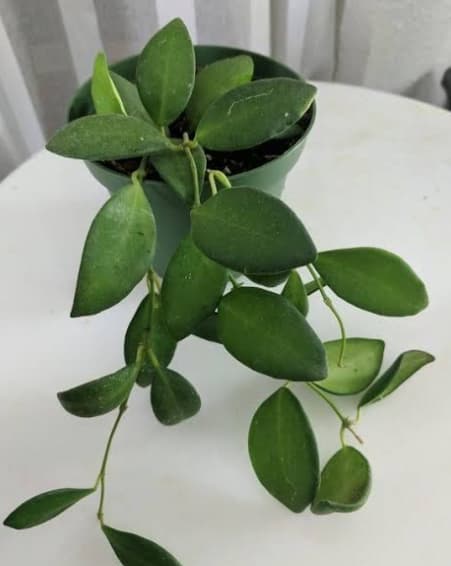
Flower
- Flower color- Dark pink flower and the center is yellow.
- Petal- Petals are strongly wrapped back up to 3 mm.
- Corona- Orange colored.
- Inflorescence- Umbels having 20 flowers. Umbels are upright and convex. The umbel size is about 1-2 inches.
- Stalk- 1-3 cm in size. Stalks remain hairless.
- Corolla- Corolla is hairless outside but shortly and densely papillose inside.
- Fragrance- Mild and sweet fragrance.
- Flower cluster- The flower cluster is small.
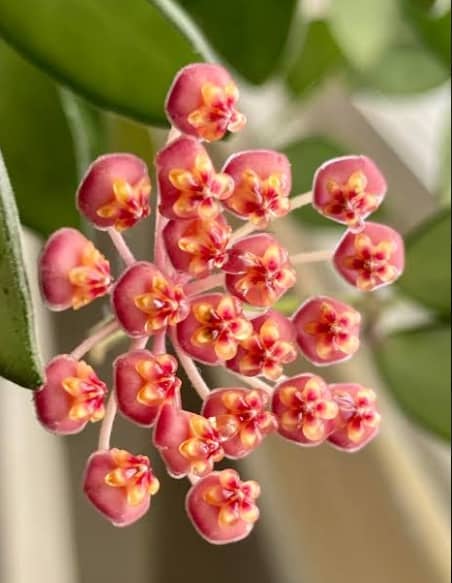
Do you know about the difference between Alocasia and Colocasia?
Hoya Burtoniae
Hoya Burtoniae is a very rare ornamental plant species. The Burtoniae Kloppenburg plant was first discovered in 1990 in the Philippines. This species was first accepted by Kloppenburg and so it is named after his name and was listed in a pictorial book-“The World of Hoyas” in Oregon. These are mainly precious for their foliage parts and flowers.
It is a beautiful collection of Hoya plants but a confusing plant to be separated from some of the other Hoya species. A term should be cleared in this case. Hoya Sp. Aff. Burtoniae may be thought of as another name of Hoya Burtoniae. But this is completely a wrong idea. Hoya Sp. Aff. Burtoniae is a type that looks a lot like Hoya Burtoniae. But these are not the same.
I think this is the time to go through some elaborate description of this plant type-
Leaf
The leaf color is completely dark green. We can compare it to the Olive green color. The leaf has a darker green margin. Sometimes you may find a light purple touch in the vine. The new leaves may show you a beautiful and brown or purplish glance. The foliage is really attractive.
You may have a fuzzy feeling while touching the leaves. The waxy foliage is very pretty because of its attractive variation in color from teenage to maturity. The leaf is ovate. The new leaves are almost oblong, lanceolate, oblanceolate etc.
I want to clear up any confusion in this case. Sometimes, Hoya sp. Aff. burtoniae is together with Hoya burtoniae. I cleared it earlier that some characteristics between them must be different. I want to clarify this more properly.
The leaf shape will make you understand this factor. The Hoya Sp. Aff. burtoniae leaves are almost elliptical but Hoya Burtoniae leaves are not so. Maybe you may have the only difference in this section properly because the other characteristics are almost the same.
Flower
Spur- The spur is that place from where flowers are produced. In the first emergence of a spur, flowers may not be produced. But in the blooming time, buds emerge from them. Spurs are produced from the axils of leaves and stems.
Spurs don’t change. Every time the flowers are produced from the same spurs.
- Color– Red-colored flower with a yellow and pink center.
- Shape– The flowers are star-shaped.
- Cluster– the flowers are born in clusters. They look made of wax.
- Fragrance– Sweet smell like honey.
- Peduncle– Many
- Inflorescence– Umbel-like inflorescence which is made up of many flowers. The flowers may be hanging or upright.
- Flower surface– Covered in tiny hairs giving a fuzzy appearance.
- Nectar– Flowers can produce excess nectar. Nectars drip from the flowers.

This 55-page printable garden planner includes all the necessary tools for gardening success – from planning and planting to harvesting and maintaining your garden.
With sections for garden design, plant care, and harvesting, this planner makes it easy to track your progress and stay on top of all your gardening tasks.
So, whether you’re a seasoned gardener or just starting out, this planner is the ultimate tool for achieving your gardening dreams!
Stem

Hoya Burtoniae plants’ stems are like herb stems. They are trailing and climbing stems with no woody portion. The stem is not branched.
Why are we talking about Hoya Burtoniae vs Bilobata?
Hoya burtoniae and Hoya bilobata are two of those ornamental plants which can be your source of mental pleasure. But these two are always in a mess because of their characteristics. So, to finally decorate with a specific one, you need to go through the ins and outs of them.
Well, we have gotten some primary ideas about Hoya Bilobata and Hoya Burtoniae. But maybe you are confused about their characteristics. At the time of selecting them, you may have some problems as they have so many similarities. Many of us can’t differentiate them at all along with nurseries. So, let’s have a look at the common differences between these two Hoya species.
Let’s have some detailed information.
Let’s explore amazing Pothos Varieties.
Plant Height
Plant size of Hoya bilobata is smaller than Hoya burtoniae. The nodes and petioles are densely organized.
The Hoya burtoniae possess a plant size of 1 meter or 39.37 inches or 1 meter. But the plant Hoya bilobata consists of 0.6 meters or 24 inches. This is the average plant size of them.
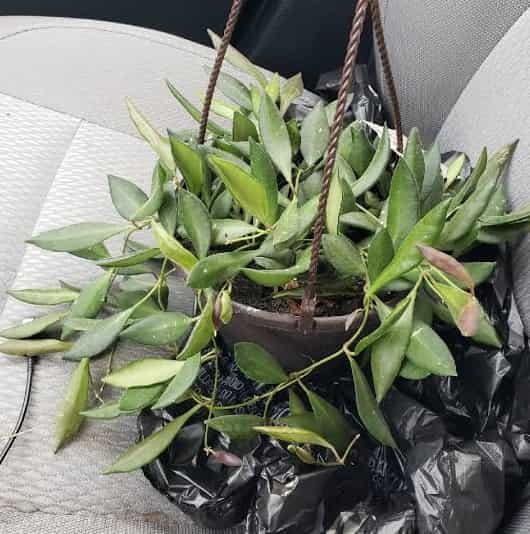

Leaves
- Leaf shape- leaf shape is almost rounded in bilobata with a small petiole. But burtoniae petiole is comparatively larger and with an ovate shape.
- Leaf size- Like the plant height, bilobata plants consist of small leaves. But burtnoiae leaves are larger than that of bilobata.
- Vines- The vines are much clearer in bilobata plants. They are found to be a little twinning. But such clearance may not be found in burtoniae leaves.
- Pubescence- Pubescence means the time when puberty or maturity is started. You may try to feel the waxy material increasing in burtoniae that indicates puberty. But such pubescence is not found in bilobata.
- Leaf quality- You may have a smooth feeling while touching the bilobata leaves. Though both of the plants belong to the waxy genus. But the wax material is comparatively low in bilobata. Fuzz-like substances will be felt when you have a burtoniae leaf.
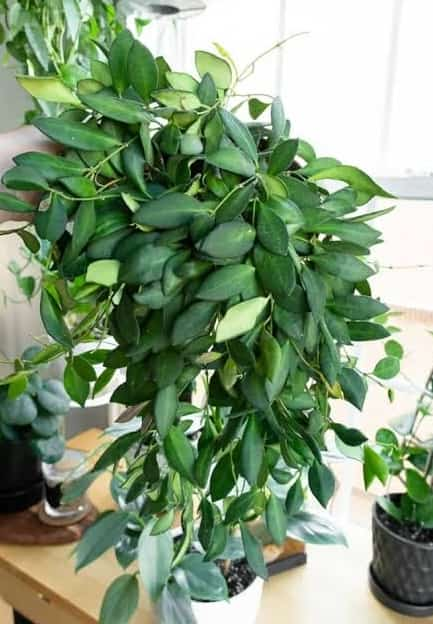

Stem
Stems are branched in bilobata. But the burtoniae stems are not branched though they have more height than bilobata.
Flower
- Flower size- Flower sizes are not so large in bilobata. But burtoniae flowers have a comparatively larger appearance.
- Flower color- The colors of the flower are pink colored with most of the time red or dark pink or orange center. But the flower color is yellow centered in burtoniae.
- Cluster- The flower cluster is smaller in bilobata than burtoniae. Bilobata consists of a cluster of 1-2”.
- Flower surface- Like the leaves, flower surface is found mellifluous in bilobata. But waxy materials cover the burtoniae flowers.
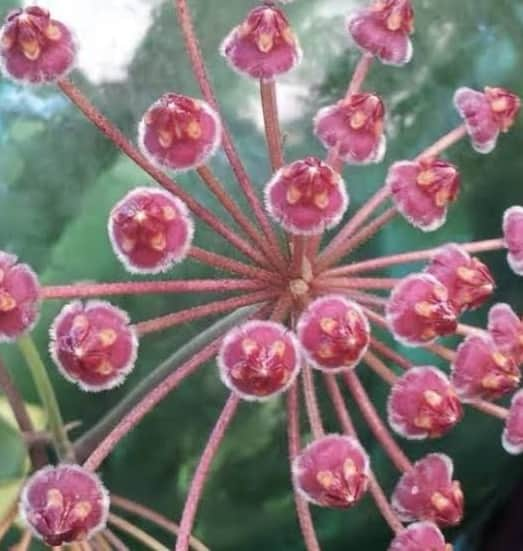
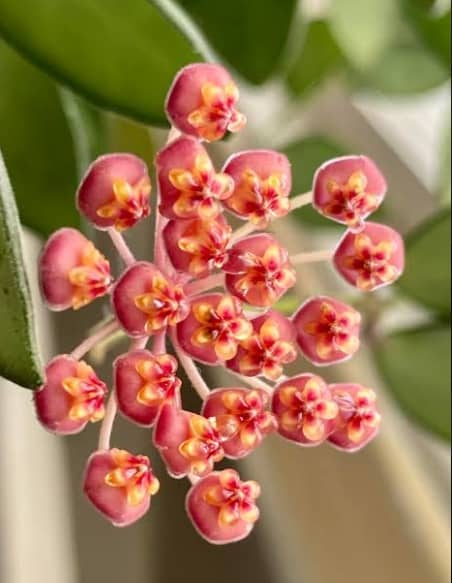
Whoo! To remove all the clutters, I think you should now have some ideas about the similarities between these two species.
Similarities Between Hoya Bilobata and Hoya Burtoniae
The similarities between these two Hoya species are connoted here-
- Leaf color– Olive green color in the upper side with dark green margin.
- Inflorescence– Umbel
- Blooming time– Spring to late summer.
- Planting season– Early spring to late winter.
- Soil– Sandy loam soil.
- Growing place– Epiphytes.
- Propagation– Cutting.
- Potting– Pot plants or may be produced in hanging baskets. Repotting is needed after every 2 years.
- Light – Bright light but indirect. Early morning or evening light is preferred. But scorching heat is hampering.
- Preferred temperature to grow– 60-95 Fahrenheit.
- Water requirement– Proper watering to keep the soil moist but water-clogged situations are avoided.
- Pruning– Heavy pruning should not be done.
- Fertilizer-once in every month during active growth.
- Diseases– Yellowing leaves, slow growth, dropping off new leaves etc. and attack of pests.
Let’s have the overall description of these similarities.
Leaf Color
Both of the species produce the same colored foliage and it is olive green with purplish or dark green margins. But the dark color is only seen in the upper side which is exposed to the lights. The light green color is seen on the underside of the leaf.
Stem
Both of the stems are very soft and they have no woody portion. All over it can be said to be a stem of herb plants.
Blooming Time
The blooming time is the same for the two species. The time is from spring to Late Summer. Both of the flowers produce star-shaped flowers from the umbel-like inflorescence. The sweet scent becomes strong in the early morning. Around 15-25 flowers are produced in an umbel from the spurs. The flowers normally mature in two to three weeks.

Planting season
The late winter season is supposed to be best for planting. Early springtime is also suitable for planting. In this season, the plant can get a proper environment to be nourished. But keep in mind that these plants are not tolerable of frost.
Soil
The soil should be finely mixed with the growing mediums. Coarse sands are not so appropriate in this case. Sandy loamy soil may have a good effect on plant growth.
There is another important factor and that is soil pH. It should be neutral or slightly acidic which means the soil should have a pH between 6 and 7.
Growing Medium
Hoya bilobata and Hoya Burtoniae both of the plants may be potted in an airy and light-medium consisting of the pot.
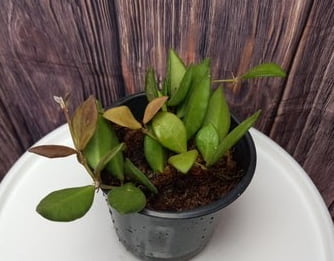
Sphagnum moss, perlite, and orchid bark should be mixed properly in a growing medium.
Another important factor is mounting. Without a substrate, the plants need to be watered more often. To improve this condition, mounting is needed. The plants can be mounted on wood and can be wrapped in Sphagnum. But it should be noted that the drainage system should be very well so that the roots are not rotten.
Propagation
These plants are propagated by stem cutting or by seeding. But cuttings must have at least one node to be propagated successfully. Cutting is the most preferable method for propagation.
Potting and Repotting
These plants are pot-bound and they grow well in small pots. The small pots help the root to be pot-bound. The smaller pots are favorable for flowering. The terracotta pots are porous and they can remove more water from the pot.
You should also keep in mind that your plant will need repotting after every two years. It is very necessary for the vigorous growth of plants.
Sunshine
Hoya bilobata plants normally prefer indirect sunlight. They can go through well by 60-95 degrees Fahrenheit. A temperature below 50 degrees Fahrenheit may cause chill damage to your plants.
They are normally comfortable inside the house. The sunlight of early morning or late afternoon is considered to be suitable for them. But the mid-noon sun may cause severe problems to them.
If your leaf is more exposed to scorching sunlight, it may cause leaf burn.
Water-requirement
Hoya bilobata plants need a well irrigation and drainage system. It prefers such a situation where excess water is not clogged. But water is needed properly so that the soil doesn’t get dried.
The watery environment means a humid area is perfect for them to be nourished. As they originate from tropical and sub-tropical areas, they may tolerate rainfall. But you should remain concerned about the drainage system.
The excess water-clogged condition may cause the leaves yellowing.
Do you know about the difference between Hoya Rebecca vs Sunrise?
Pruning and Training
As a gardener, you might be familiar with the terms pruning and training. These are the practices that you need to keep a consistent frame of your plant. The excessive branches are removed to keep a beautiful shape in your plants.
But be alert! These plants may not be able to tolerate more training and pruning. So, don’t practice this frequently. Let your plants be coped up with the cutting.
Fertilizer
Hoya Burtoniae and Hoya Bilobata plants are such plants that do not need more fertilizers than other plants. You must be familiar with the macro and micro-nutrients needed for a plant. Just apply them. To boost healthy growth, you may use a fertilizer high in phosphorus called “Bloom booster”.
Using organic fertilizers may also improve foliage and flower blooming. Fertilizer should be added once a month when the plant is in active growth.
Diseases
As these plants are comfortable in moisture, moisture-loving diseases or plant pathogens may attack. Powdery mildew, Canker, spider mites, thrips, scales etc. may attack. Botrytis blight is a common disease of these two plants. Black or brown stems, root wilting and rotting, blackroot etc. are the symptoms of such an attack.
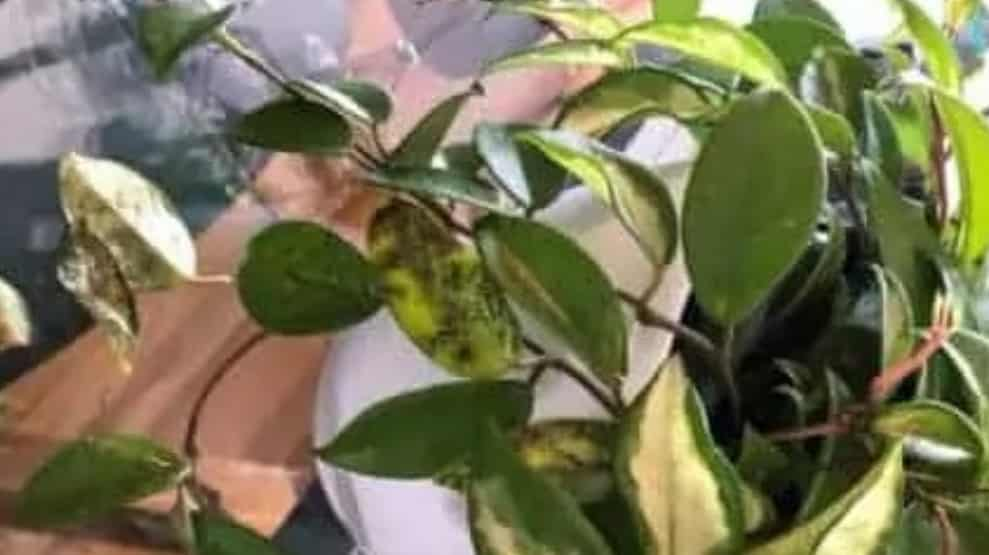
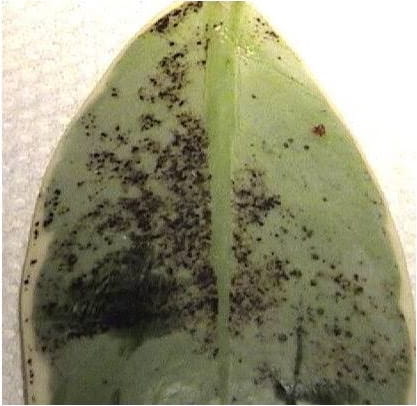
Pest Attack
Sooty mold is the other fungus that creates black spots in the leaves and the beauty of the plants is demolished. It is caused because of the attack of mealybugs, aphids, and sap-sucking insects.
But you don’t need to be worried. Neem oil, insecticidal soap, etc. may kill these pathogens. Again, you may also use pesticides which include sulfur, mancozeb, copper, captan, chloroethanol, thiophanate methyl, etc. These may solve the problems of your plant.
Yellowing leaves, thin or wrinkling leaves, etc. problems are caused by excessive water conditions. In this case, the watering frequency should be checked and the drainage system should be proper.
Dropping of new leaves, slow growth, misshapen leaves, etc. problems are caused because of water stress, excess temperature, or environmental problems. These should be checked properly.
Which Hoya Species is Best Between the Two of Them?
Well, we need to differentiate these two species for our purposes.
- Easy to care–
Hoya burtoniae plants can be easily maintained but bilobata maintenance is a little harder than that. Burtoniae may need little amount or little frequency of fertilizers than hoya bilobata.
- Toxicity– The Hoya bilobata plant can’t be said to be toxic. But it may have some problems for those who have an allergic condition. Hoya bilobata has a milky latex sap which may irritate people having an allergy or some kind of sensitivity.
But Hoya burtoniae have not expressed such problems.
- Availability–To get Hoya burtoniae is supposed to be impossible sometimes. Firstly, it is a rare plant. Besides, the maximum time the nurserymen also get confused between other Hoya burtoniae and other Hoya species like Hoya DS-70. Most often Hoya Sp. Aff. Burtoniae is exchanged with Hoya burtoniae. So, it can’t be surely said if you will find the actual Hoya burtoniae or not.
Hoya bilobata is also a confusing species. But it has no such look-alike as Hoya burtoniae has called Hoya Sp. Aff. Burtoniae. So, bilobata is easier to get than burtoniae.
- Prize– As Hoya burtoniae is a rare species, it costs a little bit higher than Hoya bilobata. For example, a Hoya burtoniae rooted cutting may cost you $27.28 whereas Hoya bilobata will cost $18.40 without a pot.
It was the general terms about their quality. Now, it is completely your decision which Hoya species will be preferred by you.
Do you know the difference between Hoya Krimson Queen and Krimson Princess?
Final Thought
Hoya bilobata and Hoya burtoniae are very similar in their characteristics. Sometimes you will find that the renowned nurseries are making a mess about them.
They may send you Hoya Bilobata though you wanted Hoya Burtoniae. So, to avoid such a situation, have a brief knowledge about these two Hoya plants and enjoy your gardening. Good luck!

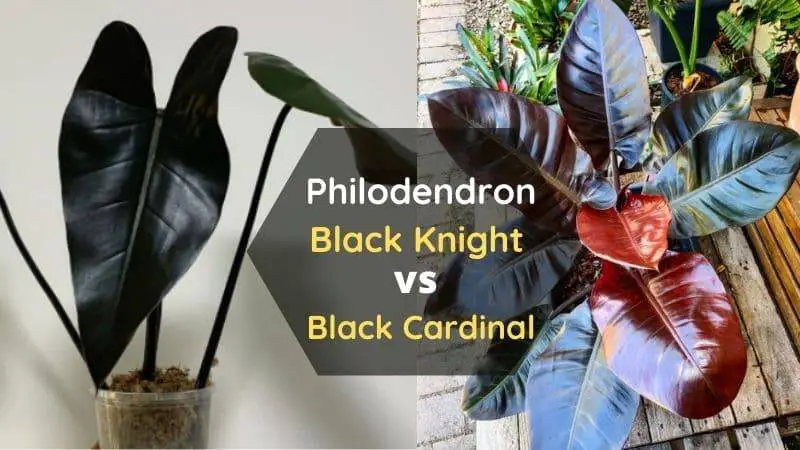
![Why are My Golden Pothos Leaves Turning Yellow? – [!Fix Now]](https://diaryforgardening.com/wp-content/uploads/2022/02/Golden-Pothos-Leaves-Turning-Yellow.jpg)
![Can jade grow in water? [3 Things you should know]](https://diaryforgardening.com/wp-content/uploads/2022/04/Can-Jade-Grow-in-Water.jpg)
![Is jade a succulent? [or tropical!!]](https://diaryforgardening.com/wp-content/uploads/2022/05/Is-jade-a-succulent.jpg)

![Do Deer Eat Coleus? [!Fun Facts Explained]](https://diaryforgardening.com/wp-content/uploads/2022/02/Do-Deer-eat-Coleus.jpg)
